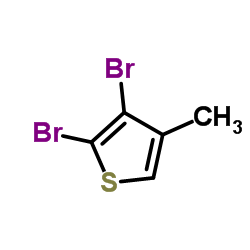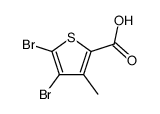125257-38-7
| 中文名 | 2,3-二溴-4-甲基噻吩 |
|---|---|
| 英文名 | 2,3-Dibromo-4-methylthiophene |
| 中文别名 | 2,3-二溴-4-甲基噻吩 |
| 英文别名 |
5.6-Dibrom-2-nitro-p-kresol
2,3-dibromo-4-methyl-6-nitro-phenol 2,3-Dibrom-4-methylthiophen 5.6-Dibrom-3-nitro-4-oxy-toluol 2,3,5,6-TETRAFLUORONITROBENZENE Phenol,2,3-dibromo-4-methyl-6-nitro 2,3-dibromo-4-methyl-thiophene 2,3-Dibromo-4-methylthiophene 2,3-Dibrom-4-methyl-6-nitro-phenol |
| 密度 | 2.0±0.1 g/cm3 |
|---|---|
| 沸点 | 241.4±35.0 °C at 760 mmHg |
| 分子式 | C5H4Br2S |
| 分子量 | 255.958 |
| 闪点 | 99.8±25.9 °C |
| 精确质量 | 253.840027 |
| PSA | 28.24000 |
| LogP | 3.80 |
| 蒸汽压 | 0.1±0.5 mmHg at 25°C |
| 折射率 | 1.621 |
| 储存条件 | 2-8°C |
|
Section1. IDENTIFICATION OF THE SUBSTANCE/MIXTURE Product name: 2,3-Dibromo-4-methylthiophene Section2. HAZARDS IDENTIFICATION Classification of the substance or mixture According to Regulation (EC) No1272/2008 Acute toxicity, Oral (Category 4) Serious eye damage (Category 1)
According to European Directive 67/548/EEC as amended. Harmful if swallowed. Risk of serious damage to eyes. Label elements Pictogram Signal wordDanger Hazard statement(s) H302Harmful if swallowed. H318Causes serious eye damage. Precautionary statement(s) P280Wear protective gloves/eye protection/face protection. P305 + P351 + P338IF IN EYES: Rinse cautiously with water for several minutes. Remove contact lenses, if present and easy to do. Continue rinsing. Hazard symbol(s) XnHarmful R-phrase(s) R22Harmful if swallowed. R41Risk of serious damage to eyes. S-phrase(s) S26In case of contact with eyes, rinse immediately with plenty of water and seek medical advice. S36/37/39Wear suitable protective clothing, gloves and eye/face protection. Other hazards Lachrymator. Section3. COMPOSITION/INFORMATION ON INGREDIENTS Formula: C5H4Br2S Molecular Weight: 255,96 g/mol CAS-No.EC-No.Index-No.ClassificationConcentration 2,3-Dibromo-4-methylthiophene 125257-38-7--Acute Tox. 4; Eye Dam. 1;- H302, H318 Xn, R22 - R41 For the full text of the H-Statements mentioned in this Section, see Section 16. Section4. FIRST AID MEASURES General advice Consult a physician. Show this safety data sheet to the doctor in attendance. If inhaled If breathed in, move person into fresh air. If not breathing, give artificial respiration. Consult a physician. In case of skin contact Wash off with soap and plenty of water. Consult a physician. In case of eye contact Rinse thoroughly with plenty of water for at least 15 minutes and consult a physician. If swallowed Never give anything by mouth to an unconscious person. Rinse mouth with water. Consult a physician. Section5. FIRE-FIGHTING MEASURES Suitable extinguishing media Use water spray, alcohol-resistant foam, dry chemical or carbon dioxide. Special protective equipment for fire-fighters Wear self contained breathing apparatus for fire fighting if necessary. Section6. ACCIDENTAL RELEASE MEASURES Personal precautions Use personal protective equipment. Avoid breathing vapors, mist or gas. Ensure adequate ventilation. Evacuate personnel to safe areas. Environmental precautions Do not let product enter drains. Methods and materials for containment and cleaning up Soak up with inert absorbent material and dispose of as hazardous waste. Keep in suitable, closed containers for disposal. Section7. HANDLING AND STORAGE Precautions for safe handling Avoid contact with skin and eyes. Avoid inhalation of vapour or mist. Normal measures for preventive fire protection. Conditions for safe storage Keep container tightly closed in a dry and well-ventilated place. Containers which are opened must be carefully resealed and kept upright to prevent leakage. Recommended storage temperature: 2 - 8 °C Moisture sensitive. Light sensitive. Heat sensitive. Handle and store under inert gas. Section8. EXPOSURE CONTROLS/PERSONAL PROTECTION Personal protective equipment Respiratory protection Where risk assessment shows air-purifying respirators are appropriate use a full-face respirator with multi-purpose combination (US) or type ABEK (EN 14387) respirator cartridges as a backup to engineering controls. If the respirator is the sole means of protection, use a full-face supplied air respirator. Use respirators and components tested and approved under appropriate government standards such as NIOSH (US) or CEN (EU). Hand protection Handle with gloves. Gloves must be inspected prior to use. Use proper glove removal technique (without touching glove's outer surface) to avoid skin contact with this product. Dispose of contaminated gloves after use in accordance with applicable laws and good laboratory practices. Wash and dry hands. The selected protective gloves have to satisfy the specifications of EU Directive 89/686/EEC and the standard EN 374 derived from it. Eye protection Tightly fitting safety goggles. Faceshield (8-inch minimum). Use equipment for eye protection tested and approved under appropriate government standards such as NIOSH (US) or EN 166(EU). Skin and body protection Complete suit protecting against chemicals, The type of protective equipment must be selected according to the concentration and amount of the dangerous substance at the specific workplace. Hygiene measures Handle in accordance with good industrial hygiene and safety practice. Wash hands before breaks and at the end of workday. Section9. PHYSICAL AND CHEMICAL PROPERTIES Appearance Formliquid Safety data pH no data available Melting pointno data available Boiling pointno data available Flash point> 110 °C Ignition temperature no data available Lower explosion limit no data available Upper explosion limit no data available Density1,984 g/cm3 Water solubilityno data available Section10. STABILITY AND REACTIVITY Chemical stability Stable under recommended storage conditions. Conditions to avoid no data available Materials to avoid Strong oxidizing agents Hazardous decomposition products Hazardous decomposition products formed under fire conditions. - Carbon oxides, Sulphur oxides, Hydrogen bromide gas Section11. TOXICOLOGICAL INFORMATION Acute toxicity no data available Skin corrosion/irritation no data available Serious eye damage/eye irritation no data available Respiratory or skin sensitization no data available Germ cell mutagenicity no data available Carcinogenicity IARC: No component of this product present at levels greater than or equal to 0.1% is identified as probable, possible or confirmed human carcinogen by IARC. Reproductive toxicity no data available Specific target organ toxicity - single exposure no data available Specific target organ toxicity - repeated exposure no data available Aspiration hazard no data available Potential health effects InhalationMay be harmful if inhaled. May cause respiratory tract irritation. IngestionHarmful if swallowed. SkinMay be harmful if absorbed through skin. May cause skin irritation. EyesCauses eye burns. Signs and Symptoms of Exposure To the best of our knowledge, the chemical, physical, and toxicological properties have not been thoroughly investigated. Additional Information RTECS: no data available Section12. ECOLOGICAL INFORMATION Toxicity no data available Persistence and degradability no data available Bioaccumulative potential no data available Mobility in soil no data available PBT and vPvB assessment no data available Other adverse effects no data available Section13. DISPOSAL CONSIDERATIONS Product Offer surplus and non-recyclable solutions to a licensed disposal company. Contact a licensed professional waste disposal service to dispose of this material. Contaminated packaging Dispose of as unused product. Section14. TRANSPORT INFORMATION ADR/RID UN-Number: 2810 Class: 6.1Packing group: III Proper shipping name: TOXIC LIQUID, ORGANIC, N.O.S. (2,3-Dibromo-4-methylthiophene) IMDG UN-Number: 2810 Class: 6.1Packing group: IIIEMS-No: F-A, S-A Proper shipping name: TOXIC LIQUID, ORGANIC, N.O.S. (2,3-Dibromo-4-methylthiophene) Marine pollutant: No IATA UN-Number: 2810 Class: 6.1Packing group: III Proper shipping name: Toxic liquid, organic n.o.s. (2,3-Dibromo-4-methylthiophene) SECTION 15 - REGULATORY INFORMATION N/A SECTION 16 - ADDITIONAL INFORMATION N/A |
| 符号 |


GHS05, GHS07 |
|---|---|
| 信号词 | Danger |
| 危害声明 | H302-H318 |
| 警示性声明 | P280-P305 + P351 + P338 |
| 个人防护装备 | dust mask type N95 (US);Eyeshields;Gloves |
| 危害码 (欧洲) | Xn |
| 风险声明 (欧洲) | 22-41 |
| 安全声明 (欧洲) | 26-36/37/39 |
| 危险品运输编码 | UN 2810 6.1 / PGIII |
|
~% 
125257-38-7 |
| 文献:Justus Liebigs Annalen der Chemie, , vol. 536, p. 135,142 |
| 上游产品 1 | |
|---|---|
| 下游产品 1 | |


